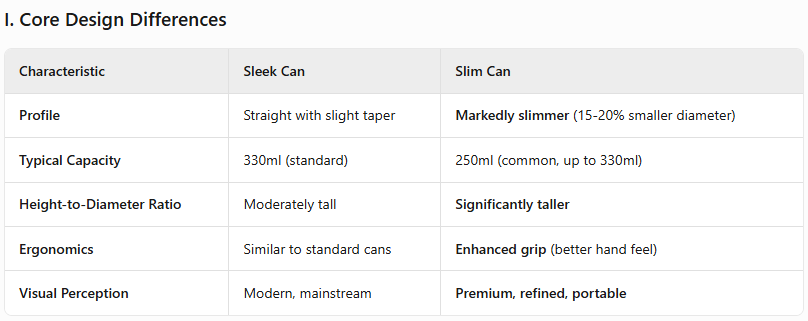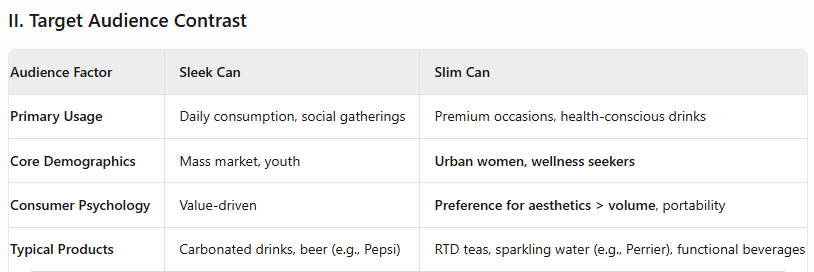Aluminum cans are everywhere in our lives, and behind their seemingly ordinary metal bodies, there are many little-known design ingenuities. For example, the difference between Sleek cans and Slim cans is far more than just “looking a bit fatter or thinner”.
I. Differences in Can Design
Sleek Can
Diameter: Typically 204 (approximately 57.4mm), slimmer than traditional cans but not extremely so.
Height: Similar to regular cans, but with a more streamlined overall design and softer shoulder curves, giving a visually refined appearance.
Capacity: Common sizes include 330ml and 250ml, adapting to diverse beverage needs.
Craft Features: Emphasizes innovation in printing and packaging, often using special techniques (such as tactile printing) to enhance brand recognition.
Slim Can
Diameter: Only 202 (approximately 53.5mm), one of the slimmest can types currently, narrower than Sleek cans.
Height: Usually taller; for example, a 330ml Slim can can reach 122mm in height, compared to 115mm for traditional cans.
Capacity: Mainly 330ml, with some brands offering 250ml or 180ml portable sizes.
Craft Features: Lightweight design with thinner aluminum (e.g., 0.265mm), resulting in lower production costs and better environmental performance.
II. Differences in Target Audiences
Sleek Can
Core Group: Young consumers (e.g., Gen Z) who pursue fashion and personalization, and value the alignment of product appearance with brand tone.
Typical Scenarios:
High-end dining or bar settings, such as co-branded craft beers.
Holiday marketing or limited-edition products, attracting collectors through design appeal.
Consumption Motivation: View beverages as social symbols and are willing to pay a premium for “good looks.”
Slim Can
Core Group: Consumers who prioritize portability and practicality, especially suitable for outdoor activities, sports, or long-distance travel.
Typical Scenarios:
Gyms or marathon aid stations for quick energy replenishment (e.g., Red Bull Slim cans).
Convenience store impulse purchases, with easy one-handed holding.
Consumption Motivation: Prioritize product functionality (e.g., rapid electrolyte replenishment) and portability, with lower price sensitivity.
III. Differences in Market Share
Global Market
Sleek Can: Holds a relatively high share in European and American markets; for example, 80% of aluminum cans in Europe are either Sleek or Slim.
Slim Can: Growing rapidly in Southeast Asia, Japan, and South Korea, widely adopted by brands like Red Bull (Thailand) and San Miguel (Philippines).
Chinese Market
Current Status: Sleek and Slim combined account for only 5% of the market, with traditional 211 cans (66mm diameter) dominating.
Trend: Their combined share is expected to rise to 75% by 2025. Slim cans, with cost advantages, will gain more ground in mass markets, while Sleek will maintain a higher share in high-end segments.
Typical Cases:
Sleek: Bingfeng sugar-free orange soda, Shanhaiguan × Capybara co-branded cans.
Slim: Red Bull silver-blue cans, functional drinks contracted by Arconic.
Summary
Design: Sleek wins with streamlined aesthetics; Slim focuses on extreme slenderness and lightweight features.
Audiences: Sleek targets the “beauty economy”; Slim serves “functional needs.”
Market Prospects: Both will become mainstream can types, but Slim is expected to grow faster due to broader cost advantages and scenario adaptability. Brands can choose flexibly based on positioning—Sleek for high-end, differentiated products, and Slim for mass consumer goods.
Erjin, a professional exporter with over two decades of dedication to aluminum can manufacturing, boasts not only a mature global export network but also an industry-leading reputation built on stringent quality control standards. From aluminum material selection to stamping and forming, every process undergoes 32 precision inspections, ensuring the can body’s compressive strength exceeds 200kPa and the coating adhesion is zero-peel. This makes them perfectly suited for storage needs amid maritime turbulence and extreme climates.
In the field of customization, Erjin’s core competitiveness stands out prominently. Whether it’s matte-textured Sleek cans crafted for craft beer or high-transparency Slim cans designed for functional beverages, full-dimensional customization is available—encompassing can shape curvature, printing techniques, and opening methods. Clients merely need to provide flavor characteristics and brand tonality, and the team can deliver over 3 structural proposals within 72 hours. For instance, anti-corrosion inner wall treatments for fruity drinks or pressure-resistant seam technologies optimized for carbonated beverages, transforming aluminum cans from mere containers into extensions of product selling points.
Notably, among Erjin’s annual export volume of over 1 billion cans, the 330ml Sleek can consistently holds half the market share. This can type, with its golden diameter of 57.4mm paired with a height of 115mm, not only preserves the integrity of the printing layout (displaying 15% more pattern details than traditional cans) but also easily fits into vending machine and refrigerator slots. Hence, it has become the top choice for European and American craft beer brands as well as Japanese and Korean functional beverage manufacturers. From limited editions at the Brussels Beer Festival to best-selling items in Southeast Asian convenience stores, Erjin’s 330ml Sleek cans continue to lead the global niche market with the dual advantages of customization flexibility and quality stability.
Post time: Jul-16-2025









